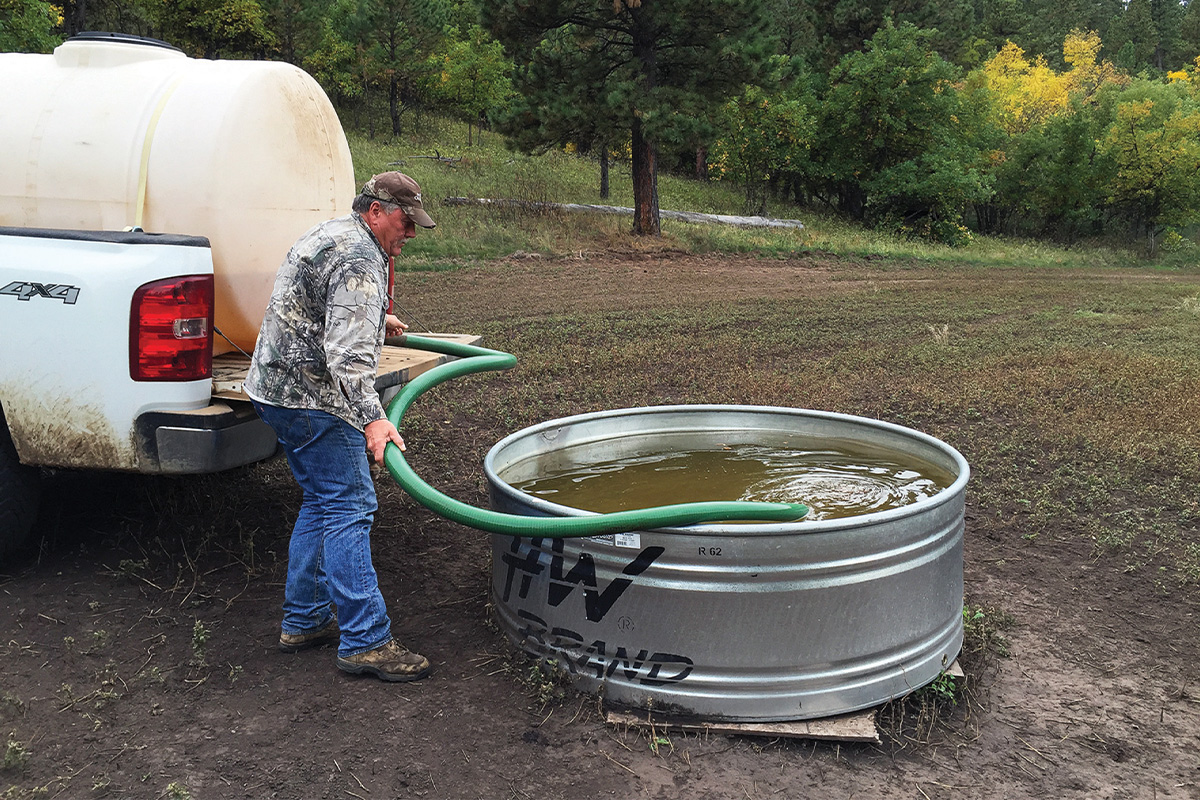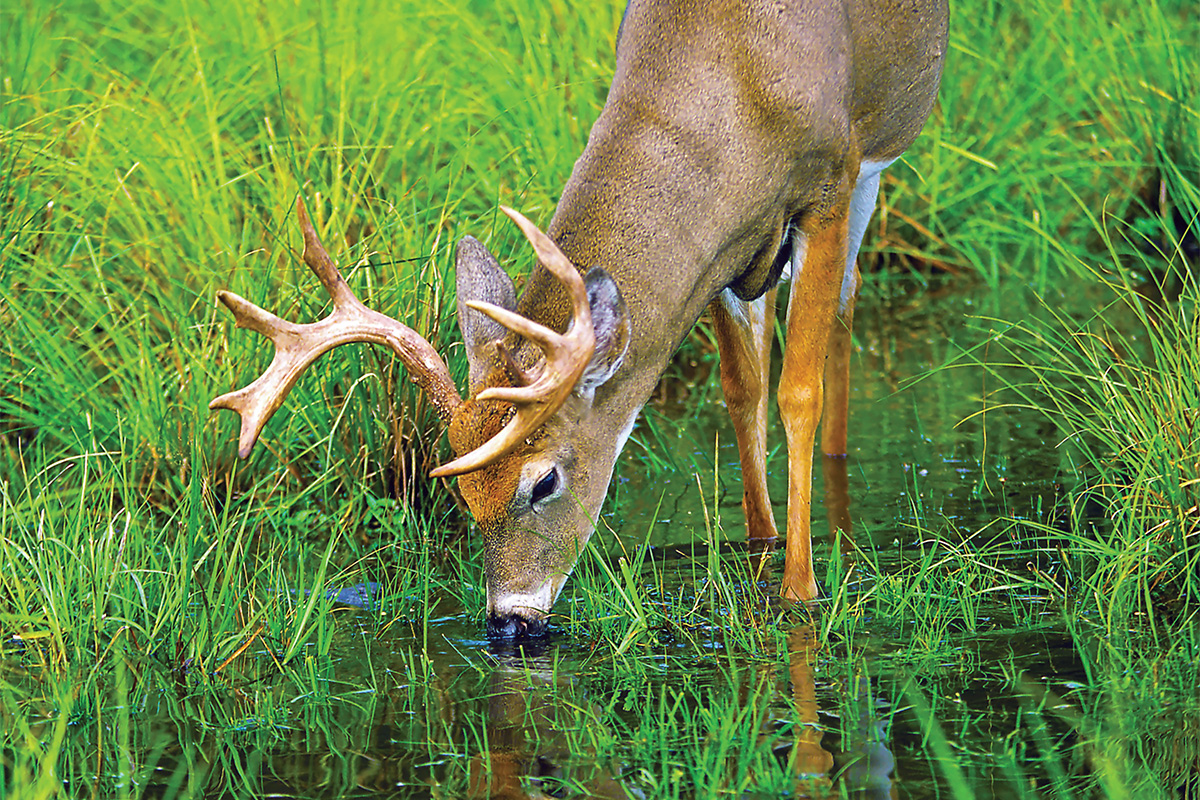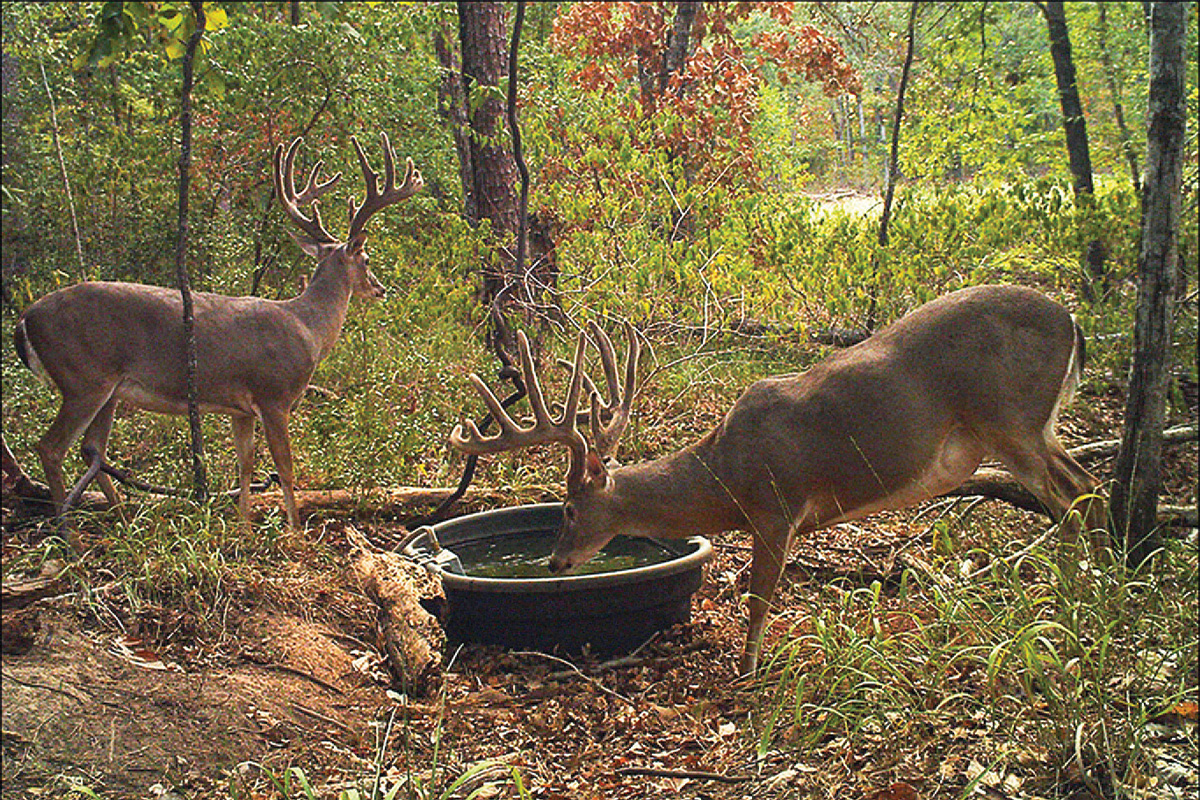
Mike Schmid of Solitude Ranch & Outfitters refills a tank drawn down by thirsty deer.
In searching for life elsewhere in the universe, the primary criterion scientists use to identify candidate planets is the existence of water. Mammals generally are composed of 70-75 percent water, and all known plants and animals contain some amount of it. In fact, most species must ingest free water every day. White-tailed deer are no exception. But if you were to ask a group of hunters or landowners to name the most important factors in deer herd health, water probably wouldn’t end up in the top three.
In eastern North America, water seldom is considered to be limiting, as there usually appear to be creeks, rivers, ponds and lakes within easy reach. Yet it has been our experience that every deer-management program should consider water availability in terms of both timing and location. Here at the Institute for Whitetailed Deer Management & Research in East Texas, over the past 30 years we’ve studied all aspects of water needs for whitetails, particularly the when, where and how of supplying it.
THE NEED FOR WATER
A whitetail needs from one-half to one gallon of water per day throughout the year. This is principally to support rumen activity, body temperature regulation and electrolyte balance.

There’s long been a misconception that the greatest water requirement occurs during the hotter months. You might be surprised to learn there’s an equal — and in some cases greater — water demand during winter. The increased metabolism required to maintain body temperature places a huge demand on internal water resources. Having often hunted the far North Woods in subzero temperatures, I can attest to my own need for additional water under such conditions. When all surface water is frozen, deer stay hydrated through water content in browse.
The bottom line is that any sound management program should include a significant effort to ensure deer have water readily available every day of the year. The primary questions, then, focus on how and where to provide that water.
While bucks are well known to be quite vagrant during the rut, whitetails have relatively small home ranges during most of the year. In many cases, the majority of their year is spent inside a square mile. Going even farther, the actual area a whitetail would “prefer” to roam is only about 100 acres during much of the year. We learned this during our early radio-telemetry studies here in East Texas, in which we monitored what happened to average home range size as we gradually improved habitat to the perfect distribution of key elements.
Unfortunately, much whitetail range falls far short of this potential. In developing management plans for landowners, the first thing we do is overlay a 100-acre grid on a property map (even if it’s smaller than 100 acres), then determine what key habitat elements are present or absent in each grid. For smaller properties, we examine what the neighboring lands within the 100-acre grid provide. One of those key elements is year-round water sources.
However, water sources often can’t be counted on throughout the entire year. Even perennial streams dry up during times of drought. That is when supplemental water can be critical. Ponds and lakes often freeze over during much of the winter, effectively creating a “desert” environment for your deer. So, being able to anticipate when and where water will be lacking is a very important part of management.

We often search historical climatic records to get a better idea of the reliability of water sources in a specific area. Local residents and resource management professionals also can be good sources of information in making such assessments. In general, however, we always add in a worst-case scenario to every management plan, just to be safe. Remember, while whitetails don’t want to migrate during hard times, they can and will do so if things turn bad enough. Adding a reliable water source, even when it appears there’s no need for one, is a wise management strategy.
Whitetails can be very “picky” about the water they drink, but not necessarily in the way you’d think. They tend to avoid running water, presumably due to the noise flowing water makes. Also, the places from which deer prefer to drink often contain water you wouldn’t even consider drinking! Mud puddles filled with green algae scum often are highly preferred by deer.
Our research has shown deer tend to use other criteria for choosing watering locations. In 2011, we conducted a study near Alice, Texas, to determine which factors influenced the choice of watering areas by whitetails. We took measurements of the physical characteristics, water quality, surrounding vegetation and proximity to human activity (roads, hunting blinds and residences) for each of 27 artificial watering stations on an 810-acre ranch.

Most of the watering stations were constructed by excavating depressions and supplying each with a “dripping” faucet connected to a network of PVC pipes from a well. We used infrared trail cameras to monitor each location’s use by deer and other wildlife. Then we compared use to a host of variables, looking to determine which had the greatest impact. Fourteen habitat variables, 28 water quality variables, five water characteristic variables, and seven spatial variables (distances to roads, habitations, feeders, hunting blinds and other water sources) were measured for each location.
During this year-long study, we recorded an impressive array of animals using our watering sites. Among them were whitetails, turkeys, bobcats, coyotes, small mammals, birds and reptiles. It was obvious that supplying supplemental water benefitted far more than deer. In late spring, we recorded 671 visits to water stations by 177 bucks and 494 does. In late summer, we recorded an additional 353 buck, 734 doe and 143 fawn visitations. The most important variable influencing deer visits was the distance to the nearest high-use road. This accounted for an estimated 62.9 percent of variation, with water stations nearest to the main ranch road receiving the lower number of visits. Not surprisingly, water stations near human activity were used less than those left undisturbed.
Water stations near hunting blinds also received less use, even outside of the hunting season. Stations surrounded by a diversity of screening vegetation with a large amount of bare shoreline were preferred. Our study also showed preference for water near food sources. Meanwhile, water quality appeared to have little impact on use. If you want to develop some artificial watering stations, we suggest you consider places that are away from roads and human habitations, are near food sources and have adequate screening cover to provide security to your deer. The next question is, what’s the best way to supply water to deer?
Water can be supplied in many ways, including ponds, lakes, water troughs and dugouts with a water supply. We’ve experimented enough to see that each has its positives and negatives. In the case of ponds and lakes, there’s the obvious negative of cost. Here in East Texas the cost of constructing a half-acre pond is about $5,000, including layout, excavation and dirt work. The cost of a true lake can run into the hundreds of thousands of dollars.
The benefit of a pond or lake is that it can provide other recreational benefits, forest protection and potential income. A pond with a surface acre of water should be valued at $30,000 in added benefits, particularly from fisheries. Yet not every parcel of land has potential sites for impoundments. And even when there are suitable sites, soils might be limiting (low water-holding capacity). Another negative to consider is such deer diseases as epizootic hemorrhagic disease and bluetongue. In times of low rainfall, the water level drops significantly, exposing muddy shoreline. These viral diseases are vectored by biting midges (gnats), whose maggots live and mature in rich organic mud. The midges emerge as adults in the late evening, when deer come to water. They have a blood meal by biting the exposed stomach skin of a deer, infecting it with the virus in the process. Sick deer also tend to come to the water to cool off from high fever; setting up a perfect storm for spreading diseases.
For many years, Dr. Kroll managed the Four Canyon Ranch near Camp Wood, Texas. This scenic area lying on the southwestern edge of the Edwards Plateau is comprised of rough limestone outcrops and canyons. In spite of its scenic grandeur, the ranch is conspicuously lacking in surface water. Wells are expensive to drill and often fail to produce, making supplying water to deer an expensive proposition. Over dinner, owner Ken Bailey and Dr. Kroll hatched a scheme to economically supply water evenly over the ranch. Instead of drilling wells, why not place water tanks connected to water troughs in strategic locations?
Of course, there had to be a water supply. The answer to that question came in the form of a surplus water truck costing $2,000. It was easily filled from a nearby river, with water then being carried to the tanks. This began over 25 years ago, and as far as we know, that truck is still in service. Since that time, we’ve had phenomenal success deploying water stations — each composed of a tank, water line, shallow trough and float valve — across North America.
In Texas, it was this system that saved many deer herds during the so-called “millennial” drought of 2011, even as other landowners lost large numbers of deer. Subsequent research revealed a surprising added benefit. You might think that deer use the artificial sites only when water is limiting; however, we discovered they continue to use them even when water is plentiful. We recently discovered the reason for this. Deer, especially does, tend to avoid social conflicts between rival “clans.” Well-spaced water and food sources tend to reduce these conflicts, which have the added benefit of increased fawn survival and antler quality.
Lastly, artificial water sources can actually reduce disease in the deer herd. Many professional biologists say we should avoid anything that attracts deer to a specific site, because bunching theoretically could spread certain diseases. However, our research has shown that providing artificial water is biologically sound.
For starters, supplemental water sources can help to spread deer out over the landscape. Also, easy access to water reduces stress. And perhaps most importantly, such water sources reduce production of disease-transmitting organisms, such as the midges that cause the spread of epizootic hemorrhagic disease (EHD) in deer. There’s little or no mud around artificial troughs, eliminating habitat for disease vectors such as gnats and flies.
Today, we install artificial watering stations at the rate of one per 100 acres anywhere there’s no reliable natural water source. The cost of each unit is under $600. That’s less than you’ll spend on food plots, feed and attractants in the average hunting season. Average water consumption per deer is about one half-gallon per day over the year. We install a 300- or 400-gallon tank at each site, so one filling will supply approximately 600-800 deer-days of use. The average number of deer using a watering station has been no more than 12. At that rate, each station needs refilling about every six weeks.

We suggest you either acquire a black storage tank or paint yours dark green to prevent algae growth. Also, locate the tank in a shady area to avoid overheating the stored water. Although a tank must be accessible to the vehicle used to deliver the water, we try to locate watering stations away from areas of frequent human disturbance. We also like to put them adjacent to food sources such as food plots, feeders and natural food locations (browse and mast). We don’t hunt these areas, as we want to provide safe havens for doe clans and buck groups.
As we’ve yet to discover a negative in providing artificial water, we decided it was time to convey this information to the public. This might all seem like a great deal of trouble, but managing whitetails has become a sport in and of itself. The whitetail lifestyle now is a 365-day affair, and it brings far more joy than just killing a buck.








































